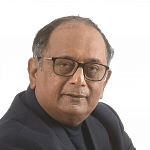So, this is what a pandemic looks like.
We've heard of these great eruptions, of course. One or two who survived the Spanish Flu pandemic. A handful may still exist who remember the Great Depression. A few more are around who survived World War II, its blackouts and shortages.
But to live through something like this is an altogether different experience, especially when you have not one but two crises rolled into one; an insidious health threat spreading fear, and crumbling economies causing panic. And that is what the Covid-19 pandemic has meant so far for the world.
At last count, at least 180 nations and territories have had at least one coronavirus case. The death toll has exceeded 239,000 and more than 3.4 million people have been infected.
And we aren't too sure if those numbers are accurate; last Monday, the Financial Times, after assessing data from 14 countries, estimated that the true death count may be 60 per cent higher than reported. The US Centres for Disease Control and Prevention says the death toll for seven US states hit hard by the pandemic could be 50 per cent higher than normal between March 8 and April 11 - 9,000 deaths more than were reported.
Other reports, citing the latest antibody studies, show that the virus has spread more widely than assumed but is also possibly less virulent than the 3 per cent to 4 per cent fatality rate the World Health Organisation (WHO) mentioned in early March.
Five decades ago, the American litterateur Archibald MacLeish, upon seeing the first photographs of Earth taken from the Moon, gushed about it as "small and blue in that eternal silence where it floats".
Today, in many places on Earth, the silence is not so much eternal as one borne out of compulsion, as shaking lambs would at the sight of approaching wolves.
Imagine, you are watching the movie Twister and suddenly you are shaking not because of the 3D effects in the hall but that you are in the midst of a tornado yourself.
For almost everyone, Covid-19 is no longer something "over there" but in our midst. From the locked-down boroughs of New York City to Sydney's Bondi beach - that totem of an outdoors-oriented land - and the shanty towns of Mumbai, it is a deafeningly silent scream.
In parts of the United States, such as Idaho where Ernest Hemingway ended his life, US farmers are culling livestock and destroying crops they cannot harvest. In India, farmers are unable to sow the summer crop even as the forecast is for a normal monsoon, which ordinarily would have meant bracing news for the rain-dependent economy.
SLOW AWAKENING
Looking back to Dec 31 - when China officially alerted the WHO to the outbreak - and to last week, when the country announced that the last of its hospitalised coronavirus patients in Wuhan had been discharged, one aspect that stands out is how slow the world had been to wake to the disease's dangers.
It was not until Jan 20 that we knew, through WHO, there were "some cases" of human-to-human transmission of the virus and it was only in the second month that we became aware there could be asymptomatic carriers spreading the disease.

Beyond those facts is a fog of recrimination involving China, the WHO and the rest of the world that will continue long into the future. This has spawned implausible theories, just as there are those who find it hard to believe that a lone gunman could have assassinated President John F. Kennedy in 1963.
If this was a natural disaster like an earthquake, tsunami or cyclone, we would have had the playbook to deal with it. However, with the prospects of an effective vaccine at least a year down the road and even then not knowing how effective it could be against a mutating virus, we have only the experience of these past four months to go by.
First, we know that nations or territories led by leaders that have relied on science - the German, Norwegian, Taiwanese and Kiwi experience suggests that women score high marks here - have tended to do better.
Second, social distancing is essential, a key element in the cautious victory over the disease proclaimed by New Zealand Prime Minister Jacinda Ardern. Hongkongers, with experience of Sars (severe acute respiratory syndrome) still in memory, knew this instinctively and it has helped the territory cope with this crisis.
Third, mass testing is vital and as South Korea has demonstrated, sometimes repeated testing of the population is required.
Singapore has set itself along the same path, accepting the odium of having Asia's fifth highest disease count after China, India, Saudi Arabia and Pakistan in the interests of wiping out the virus, root and branch.
Fourth, and perhaps most important of all, there is no escaping universal health coverage as a key element of national security.
America's abysmal record and Singapore's success in continuing to be the gold standard in limiting fatalities - never mind the rising numbers caused, in part, by diligent testing - shows the importance of investing in public health.
Asian countries that haven't invested sufficiently in health are seeing the results. Indonesia has a mortality rate of almost 8 per cent, higher than the Philippines, which has a 6.6 per cent mortality rate.
WHO figures show that Indonesia has 4.27 doctors per 1,000 people compared with nearly 23 for Singapore. President Joko Widodo's reluctance to impose a harsh lockdown, fearing the effect on the livelihoods of millions of marginal folk, has proved expensive for the archipelago, with the virus spreading to more than 250 towns and cities. Many leaders like him are having to balance a health pandemic with an epidemic of poverty.
Amid the panic of what is nothing less than a war, there is no shortage of heroic tales.
Filipino doctors, often enduring a lack of critical protective equipment, have stepped out to battle the virus, taking a heavy toll themselves. Some Singapore nurses who handled Sars have returned to the front line to tackle Covid-19.
The Washington Post recently told a story about 43 men who lived for a month inside the Braskem petrochemical plant in Pennsylvania, which produces raw material for face masks and surgical gowns. Fearing production would slow down if any of them got sick, they had volunteered to stay in the plant, working long shifts.

GLIMMERS OF HOPE
Are there the first glimmers of light at the end of a very dark tunnel? Perhaps.
Business activity in major economies collapsed last month as governments clamped down to limit the spread of the virus. Any significant revival will have to wait for the third quarter, if at all.
Now, China, first to substantially control the virus after absorbing a near 7 per cent first-quarter GDP decline, is back on its feet, even as it remains alert to a rebound of cases. While it has been cautious about sending children back to schools, most factories are running again. Travel within the mainland is stirring to life as well. Domestic Airbnb bookings, to name one indicator, reportedly rose last month from their March lows, suggesting people are moving about again.
New Zealand has begun a phased exit from the lockdown, with fishing, hiking and hunting allowed. Philippine President Rodrigo Duterte last week spoke of a "partial" lifting of the lockdown, with construction and some other sectors to restart, albeit with social distancing rules in place. Public transportation has been restored in Dubai, the most vibrant of Gulf cities.
A recent Stanford study cited by the Wall Street Journal found that those under 65 with no underlying conditions such as diabetes or hypertension made up 1.8 per cent of deaths in New York City. The Journal said the fatality rate for those over 75 is 69 times that for those between 18 and 44 years. This could suggest that while the elderly need the most protection, younger ones could possibly be sent back to work, or school.
Around the world, many leaders are at a loss as to what to do, often improvising as they go along. Given the hybrid nature of this challenge, there is no knowing what might work or won't.
Many governments - Singapore, Malaysia, Japan and Indonesia included - have thrown vast amounts of money into the fight to keep business running and jobs secure.
Nevertheless, no one doubts that the pain is going to be extremely severe. That makes it imperative that some way must be found to put people back to work.
US President Donald Trump has called to "liberate" certain American states that have imposed stay-home orders. Notwithstanding what looks like a tough election for him in November, his anxiety is understandable; the US shed some nine million jobs in the Great Recession. Today, as many jobs are being shed every 10 days.
The world needs the No. 1 economy and market of last resort back on its feet, but most think it is too early for that, never mind what their leaders think. Italy, one of the hardest hit, is considering a phased reopening.
Yet, Hokkaido's experience shows the perils of lifting lockdowns too soon. Japan's northern island did well to move early with a three-week shutdown. But when it was lifted, a second wave of infections hit and the island returned to lockdown in less than a month.
Will the pandemic prove an inflexion point in world affairs for US domination, just as the 1956 Suez Canal crisis is seen as a watershed for Britain's decline? That's too early to say.
China, once it got off its initial embarrassment over the outbreak having been first reported on its soil, won praise once it moved efficiently to curb its spread. But some of its sheen has worn off subsequently, in part because its diplomats were too eager to tout its victory and also because some of the medical equipment it shipped around the world, including test kits and ventilators, were of poor quality.
Thirty years ago, as the spaceship Voyager 1 left our planetary neighbourhood for the fringes of the solar system, engineers turned its cameras towards Earth at the request of Carl Sagan, leading the famed cosmologist to famously describe our abode as a "mote of dust suspended in a sunbeam".
"Look again at that dot," he wrote in his book, Pale Blue Dot, describing our planet and civilisation as the aggregate of our joy and suffering "where every saint and sinner in the history of our species lived".
In time to come, we will have a clearer picture of who were the saints and who the sinners in this crisis. Meanwhile, the pandemic has reminded us that we share a common destiny.

